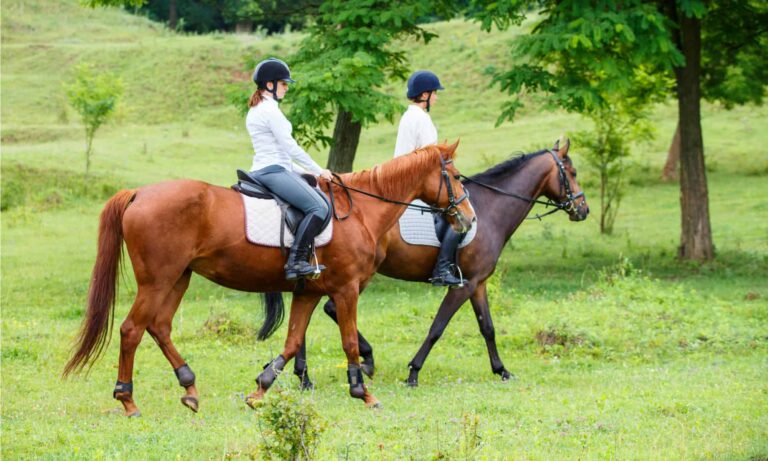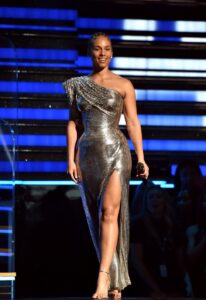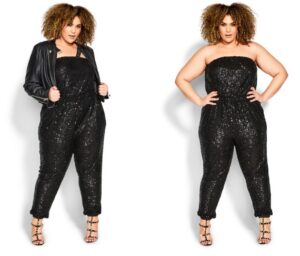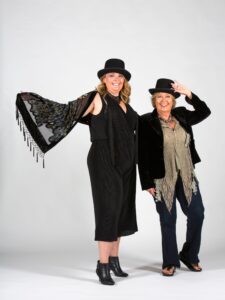Wear comfortable clothes and proper footwear, including a helmet, when horseback riding. Horseback riding attire is not only important for comfort but also for safety.
Horseback riding can be an enjoyable experience, but choosing the right attire is important for your safety and comfort. First, select clothing that allows a wide range of movement and is not too tight or restrictive. Avoid wearing slippery, loose or baggy clothes that may catch onto something or scare a horse.
It’s important to consider the weather when choosing riding attire. Choose breathable and lighter clothes for hot weather and warmer clothes for cold weather. Proper footwear is essential for safety, closed-toe shoes or boots with a low heel are recommended. Don’t forget to wear a helmet that is approved for horseback riding to protect your head in case of a fall. With these tips, choosing the right attire for horseback riding will ensure an enjoyable and safe ride.

Credit: learninghorses.com
Dress For Success: The Basics Of Horseback Riding Attire
What To Wear Horseback Riding: Dress For Success
Horseback riding can be an exciting and thrilling adventure, but it’s essential to dress appropriately to ensure your safety and comfort. Whether you’re a beginner or an experienced rider, it’s crucial to understand the basics of horseback riding attire.
Practical Clothing For Riding Comfort
Comfort is key when it comes to horseback riding. The clothing you wear must allow you to move freely without restriction. Here are some practical clothing items you should consider when dressing for horseback riding:
- Pants: Wear long pants, preferably made from stretchy, breathable fabric. Avoid wearing shorts or skirts, which may cause chafing or skin irritation.
- Shirts: Choose a well-fitted shirt that allows you to move your arms freely. Avoid wearing bulky sweaters or jackets, as they may interfere with your balance and control.
- Gloves: Wear gloves with a good grip to prevent your hands from slipping on the reins. Gloves also provide additional protection against blisters and calluses.
Safety Gear: Helmets, Jackets, And Boots
Horseback riding can be dangerous, and you must wear the appropriate safety gear to protect yourself. Here are some essential safety items to consider:
- Helmets: Wear an approved equestrian helmet to protect your head from injury. Choose a well-fitted helmet that provides adequate ventilation and does not impede your vision.
- Jackets: Wear a riding jacket or a vest made from breathable material to protect your upper body in case of a fall. Choose a brightly colored jacket for increased visibility.
- Boots: Wear sturdy, flat boots with a heel that fits snugly around your ankle. Avoid wearing running shoes or sandals as they may slip off your feet while riding.
The Importance Of Picking The Right Fabric
The fabric you choose for your riding attire is just as important as the style and fit. Here are some fabrics to consider:
- Cotton: Cotton is a breathable and lightweight fabric that’s perfect for warm weather.
- Synthetics: Synthetic fabrics like spandex and polyester offer stretch and flexibility, making them ideal for riding.
- Wool: Wool is a natural insulator and is excellent for colder weather. It’s also naturally moisture-wicking, which helps keep you dry and comfortable.
Don’T Forget The Sunscreen: The Importance Of Skin Protection
Horseback riding often involves spending long hours in the sun, making it essential to wear sunscreen to protect your skin. Here are some sun protection tips:
- Choose the right sunscreen: Look for a broad-spectrum sunscreen with an spf of 30 or higher.
- Apply it properly: Apply sunscreen at least 20 minutes before riding, and reapply every two hours or after sweating or swimming.
- Cover up: Wear a hat with a brim to shade your face and neck, and consider wearing arm covers to protect your arms from the sun.
Dressing appropriately for riding is crucial for your safety and comfort. By following these basic guidelines, you’ll be prepared for a successful and enjoyable horseback riding experience.
Tailoring Your Attire For Different Riding Disciplines
Horseback riding is an exciting activity that requires comfortable and functional clothes. And whether you’re a beginner or an experienced rider, there’s a riding discipline suited for you. Different riding styles demand different clothing and gear. Here’s what to wear for each of the three most common disciplines:
English Riding Attire: What To Wear
English riding involves trotting, cantering, jumping, and riding on a flat surface. Proper attire is essential to ensure your safety and make riding more enjoyable. Here are some key pieces of clothing to consider:
- Helmet: A properly fitted and secured helmet is essential for safety.
- Riding boots: English riding boots are tall with a distinct heel and provide excellent ankle support.
- Breeches or jodhpurs: These are specifically designed to provide comfort and flexibility while riding.
- Riding gloves: These improve your grip on the reins and protect your hands from chafing.
- Riding jacket: A show jacket is required for competition, while a lightweight jacket is suitable for daily use.
- Shirt with a collar: A lightweight, breathable shirt with a collar is ideal for english riding.
- Crop or whip: This is used to give cues to the horse and is an essential tool for english riding.
Western Riding Attire: What To Wear
Western riding emphasizes comfort, safety, and tradition. Here’s what to wear for this discipline:
- Cowboy hat or helmet: A cowboy hat is traditional, but a helmet is always a safer option.
- Western boots: These have a non-slip sole, a square toe, and a low heel for stability.
- Jeans: Loose-fitting, durable jeans are required for western riding.
- Belt: This is a functional accessory that holds your pants in place.
- Long-sleeved shirt: A comfortable, breathable, and long-sleeved shirt is ideal for western riding.
- Chaps: These are optional but are ideal for protecting your legs from the elements and provide extra grip.
- Spurs: A tool used to give cues to the horse, but only suitable for experienced riders.
Trail Riding Attire: What To Wear
Trail riding is a fun and relaxing way to enjoy horseback riding while exploring nature. Here’s what to wear for this discipline:
- Helmet: Regardless of the riding style, a properly fitted and secure helmet is a must.
- Comfortable footwear: Choose durable, closed-toe shoes with a non-slip sole.
- Long pants: Loose, comfortable pants are ideal for trail riding.
- Long-sleeved shirt: A light, moisture-wicking shirt with long sleeves is ideal for trail riding.
- Outerwear: Depending on the weather, you might need a jacket, a vest, or a raincoat.
- Gloves: Gloves provide a better grip on the reins and protect your hands from rubbing.
- Insect repellent: Protect yourself and your horse from bugs with a safe and effective insect repellent.
Horseback riding is an enjoyable activity that requires proper clothing to ensure safety and comfort. By tailoring your attire to the style of riding, you can enjoy your experience while looking and feeling great. Remember to choose comfortable, functional, and safe clothing and gear for your next horseback riding adventure.
Accessorizing For Comfort And Style
Horseback riding is a fun experience that allows riders to connect with nature and experience their surroundings in a unique way. However, choosing the right attire for horseback riding is crucial for both comfort and style. In this blog post, we will discuss how to accessorize for comfort and style while horseback riding.
Gloves, Belts, And Scarves
Wearing gloves while horseback riding can offer a better grip on reins and prevent blisters or calluses from forming on your hands. Belts are also a great addition to an equestrian outfit, not only to provide a secure fit for your pants but also to add a touch of style.
Additionally, scarves can offer protection from sun, wind or cold weather while adding some flair to your outfit.
- Gloves provide better grip on reins
- Belts secure pants and add style
- Scarves protect from weather and add flair
Choosing The Right Socks And Undergarments
Wearing the right socks and undergarments are also important while horseback riding. Socks should be tall enough to prevent chafing and provide ample padding. Choose moisture-wicking and breathable materials to keep your feet dry and comfortable. Undergarments should also be seamless and breathable to prevent any discomfort while riding.
- Socks should be tall and padded
- Choose moisture-wicking and breathable materials for socks
- Undergarments should be seamless and breathable
Jewelry And Other Accessories
Although it may be tempting to accessorize with flashy jewelry, it’s best to keep it simple while horseback riding. Anything that jingles or dangles can distract or spook the horse. Opt for small studs or earrings instead. In addition, hair should be tied back and secured to prevent any loose strands from interfering with the ride.
- Keep jewelry simple and minimal
- Opt for small studs or earrings
- Tie hair back and secure it
Remember to prioritize safety and comfort while horseback riding. By choosing the right accessories, riders can not only look stylish but also have a more comfortable and enjoyable experience.
Preparing For Different Weather Conditions
Horseback riding is an exciting activity that requires the right clothing to be comfortable and safe. No matter what the weather conditions may be, it is essential to dress appropriately to ensure the best possible riding experience. Here are some tips to consider when preparing for different weather conditions:
Cold Weather Riding: What To Wear
When it comes to cold weather riding, dressing in layers is the key. Choose comfortable, practical clothing that keeps you warm and allows ease of movement. Here are some necessary items to wear:
- Base layer: A moisture-wicking thermal top or long-sleeved shirt
- Mid-layer: Fleece jacket or vest for insulation
- Outer layer: A water-resistant jacket to protect against wind and rain
- Riding pants: Insulated tights or pants with stretch to move in the saddle
- Boots: Waterproof and insulated boots, with a thick sole and a low heel
- Gloves: Thermal gloves with good grip qualities
Hot Weather Riding: What To Wear
Riding on a hot day can be uncomfortable and exhausting, but the right clothing can help keep you cool. Light-colored, breathable materials that wick away moisture are ideal for hot weather riding. Here are some essential items to wear:
- Lightweight shirt: A moisture-wicking, breathable top to keep you cool
- Riding pants: Fabric with stretch and able to absorb moisture such as cotton or technical fabric
- Boots: Sturdy leather or synthetic tall boots
- Sunscreen: A high spf, waterproof sunscreen is essential to protect your skin from the sun’s harmful uv rays.
- Hat or helmet: Protect yourself from heatstroke by wearing a helmet or a hat with a wide brim
Rainy Day Riding: What To Wear
Riding in the rain has its own set of challenges, but the right clothing can make it more manageable. To stay dry, invest in waterproof equipment that allows ventilation. Here are some items to wear:
- Waterproof jacket: With a hood to keep your head dry
- Waterproof pants: With good grip to prevent slipping off the saddle
- Boots: Waterproof, with a non-slip sole
- Gloves: Waterproof and with good grip qualities
- Hat: Waterproof and suitable for helmet use
Dressing appropriately for weather conditions is essential to ensure a comfortable and safe horseback riding experience. Remember to dress in layers for cold weather, wear breathable clothing for hot weather, and invest in waterproof gear for rainy days. Stay safe and have fun!
Choosing The Right Clothing For Different Skill Levels
Beginner Riding Attire: What To Wear
If you are new to horseback riding, it is important to wear the right clothes to ensure a safe and comfortable ride. Here are some essential clothing items to wear as a beginner:
- Helmet: Always wear a well-fitting helmet to protect your head from falls or kicks.
- Boots with heels: Wear boots with a low heel to ensure your feet stay in the stirrups and prevent slipping.
- Long pants: Wear long pants, such as jeans or leggings, to avoid chafing and protect your legs from scratches.
- Comfortable top: Wear a comfortable and breathable top, such as a t-shirt or a light jacket depending on the weather.
Intermediate Riding Attire: What To Wear
As you gain more experience in horseback riding, you may need to invest in more specialized clothing items. Here are some essential clothing items to wear as an intermediate rider:
- Riding breeches: Investing in a good pair of riding breeches will make your ride more comfortable and allow for better movement.
- Riding gloves: Wear gloves with a good grip to help you maintain a secure grip on the reins.
- Body protection: For more advanced riding, you may need to start wearing body protection, such as a vest or a jacket with safety padding.
Advanced Riding Attire: What To Wear
If you are an advanced rider and participating in competitions, you will need to wear the appropriate attire. Here are some essential clothing items to wear as an advanced rider:
- Riding jacket: Wear a tailored riding jacket that is appropriate for your discipline.
- Riding boots: Invest in a good pair of riding boots that will provide proper support for your feet and legs.
- Safety vests: Wear safety vests specifically designed for your discipline, such as eventing or jumping.
Remember that when it comes to horseback riding attire, comfort, safety and protection should always be your top priorities. Whether you’re a beginner or an advanced rider, choosing the right clothing can enhance your performance and keep you safe on your ride.
Frequently Asked Questions On What To Wear Horseback Riding
What Should You Wear For Horseback Riding?
Riders should wear clothing that is comfortable and fitted but not too tight. Jeans and boots with a low heel are a good choice, as well as a riding helmet and gloves.
Can You Wear Sneakers Or Sandals For Horseback Riding?
Sneakers and sandals are not recommended for horseback riding since they don’t offer adequate support. Instead, riders should wear boots with a low heel to keep their foot from slipping out of the stirrup and provide extra grip.
What Type Of Helmet Should You Wear For Horseback Riding?
The most appropriate helmet for horseback riding is one specifically designed for that purpose, with a chin strap to keep it securely in place. It should be astm/sei approved to ensure its safety features.
Should You Wear Protective Gear For Horseback Riding?
Wearing protective gear when riding a horse is always a good idea. A riding helmet is essential to protect against head injury in the event of a fall. Also, gloves and boots protect hands and feet from injury and provide better grip in the stirrups.
What Fabric Should Horseback Riding Clothes Be Made Of?
Clothing made of breathable materials like cotton or moisture-wicking synthetic fabrics is recommended to keep riders comfortable and dry during their ride. Synthetic fabrics like lycra or spandex provide a good stretch to allow for comfortable movement while riding.
Conclusion
What you wear when you go horseback riding is crucial. The right outfit can keep you comfortable, safe, and stylish, while the wrong outfit can make your experience miserable. It’s important to consider the type of riding you’ll be doing, the weather, and the terrain when choosing your clothing and accessories.
Riding pants or jeans, boots with a sturdy heel, and a helmet are essential items. However, you can also express your personal style by choosing clothing in colors and patterns that make you feel confident. Remember to dress in layers and avoid bulky or loose clothing that could get snagged while you’re riding.
With these tips in mind, you’ll be ready to hit the trail or arena looking and feeling your best!





